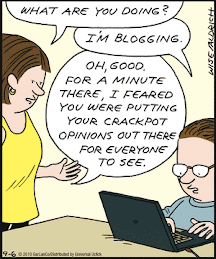Wed, Dec 29, 2010 Gary Cee
Theme: After our discussion on themes yesterday, and despite other temptations, Eye-yi-yi, I'll just go with the unifier,
EYE OPENER. For the asterisked clues, the first word of a common two-word answer can precede the word "
EYE," yielding a totally different type of two-word phrase. Lots of times these are
RIB TICKLERS, but today they're pretty straight forward.
17 A. *Unquestioning devotion :
BLIND FAITH. Belief in something, in the absence of evidence, or even disregarding contrary evidence. Don't get me started.
BLIND EYE: What the devotee turns to the imperfections of the object of his devotion.
63 A. *Knee-slapper :
RIB TICKLER. An amusing joke or story that gets gets your ribs moving with a series of tee-hees.
RIB EYE: A boneless, well-marbled steak, cut from the top of a standing rib roast. Cf. 23 D!
10 D. *Pitchers and tumblers :
GLASS WARE. The clue defines them very well. Vessels made of glass, suitable for transporting libations to and from the table, and thence to the lips.
GLASS EYE. A non-functional ocular prosthesis: an artificial
EYE made of
GLASS, the best material for this application. Sammy Davis Jr. had one. Since I'm an
EYE GLASS WEARER, I was tempted to go with the childhood taunt "
FOUR EYES" for the theme, but, alas, "
EYE" only shows up once - in the unifier.
34 D. *Like treatment for visiting dignitaries :
RED CARPET. It is literally rolled out for heads of state, and at gala celebrity events. Less formally, it indicates giving someone an unusually high level of hospitality.
RED EYE: An overnight flight from point A to point B, implying discomfort and lack of sleep, hence the
RED EYES. Probably not the usual means of transportation for someone about to walk the
RED CARPET.
And, of course, the unifier, 38 A. A 5- or 40-Down ... or what the start of each answer to a starred clue can be :
EYEOPENER. This has a few different meanings. The first is a startling revelation that gets one to see something in a new and unanticipated way. (Those with unquestioning devotion are immune.) The second is an alcoholic drink consumed early in the day, presumable to get one up and at 'em. Third, the stimulants in 5 and 49 D. But, here, it also uses a common cross-word trope to cleverly indicate that the beginning of each theme answer can precede "
EYE."
Hi gang, It's JazzBumpa, with a tumbler of ginger ale at my elbow. Glenkinchie will come a little later. I don't recognize Gary Cee's byline. This puzzle was a lot of fun, and seemed pretty fresh to me, despite a few common entries. I've been anticipating AGLET for a long time, but don't recall seeing it in a puzzle before. The pinwheel theme answer arrangement is uncommon, as is placing the unifier in the center of the grid.
Across
1. Sound return :
ECHO. I was thinking of investment returns. Now I have my eye open for clechoes!
5. Suspension bridge support :
CABLE.
Here is an example I get to drive across going to and from visiting my mother.
10. Obtain forcibly :
GRAB
14. Miller, for one :
BEER. I thought it would be a teller of a Canterbury Tale. But the miller was drunk, so it kind of fits.
15. Shoelace tip :
AGLET. For some odd reason, I love this word. "
Mom, they're tying the whole world together!"
16. Stubbs of the Four Tops :
LEVI. News to me. But he might have
just what you need.
19. Scored 100 on :
ACED. Perfect!
20. Bozo :
GOOF. Or a clown.
21. "When the smog clears in California, UCLA," e.g. :
PUN. Sheesh. I read right through this and didn't get it.
22. Hitchcock title :
SIR. Good night! I didn't know that. Nice misdirection for the director.
23. Dice-rolling game :
YAHTZEE. I haven't played
this game in years, and don't recall liking it very much.
26. The King or Prince :
POPSTAR. A royally clever clue. I think we had Jacko, the King of Pop not too long ago. Prince is the artist formerly known as "The artist Formerly known As Prince," which makes him the once and future Prince, I suppose. Never was a big fan of either. Feel free to provide links in comments.
29. Repugnant reaction :
UGH. Not now. I just took a sip of the Glenkinchie!
30. Pound sounds :
YIPS. Rhyme time for puppy noises.
32. Treatment plant input :
SEWAGE. Now -- UGH!
33. Tie up, in a way :
MOOR. I have no idea why this caused me a problem. Maybe our boaters can explain the origin if this word.
35. Home of Duke U. :
N CAR. The Raleigh-Durham-Chapel Hill region of North Carolina, a beautiful part of the world with a lot of traffic. Note Abrv. n Cl. & Ans.
37. Looks bad, comparatively :
PALES. Someone or something can PALE in comparison. But - no politics - moving right along . . .
41. Parisian daily, with "Le" :
MONDE. Lucky guess. No idea where in Le Monde it came from.
44. Singer Amos :
TORI. Never paid any attention to her. Here is a s
ong for the season.
45. Latin 101 verb :
ESSE. Stock fill.
49. Signs into law :
ENACTS. Rumor has it that making law is like making sausage. If you won't ask, I won't tell.
51. Pool room supply :
RACK. It's that triangle-shaped thingie that you put all the balls into, then take away
so you can hit them.
53. Amigo :
PAL. That's right friendly!
54. Reaches :
ATTAINS. I always like it in those old westerns when the bad guy pulls out his gun and says, "Attain the sky."
56. Chesapeake Bay city :
NORFOLK. Just across the James River is
Hampton, where my step son Tom used to live. Now, home is in FLA, and he should be back there by Friday.
58. Televise :
AIR. Hmmm. Don't they also AIR radio broadcasts?
And
36. Aired again :
RERAN. Is it a clecho if the clue echoes an earlier answer, or just an inelegance?
59. Physicians' org. :
AMA. The American Medical Association. Note Abrv.
61. Precisely :
TO A "T." Sometimes it's just a "T" and sometimes it's a "TEE." Either way,
the origin is disputed.
62. Fall :
DROP. I always think of the stock market
drop in the FALL of '29.
67. Green climber :
VINE.
68. Title owner of a sitcom bookstore :
ELLEN. Beats me. I haven't watched sit-coms in 30 years.
69. Homeland of the folk-singing Clancy Brothers :
EIRE. Always need perp help to decide between EIRE and ERIN.
70. Two out of three, say :
MOST. Is the GLASSWARE MOST full or MOST empty?
71. Teacher's directive :
SEE ME. It means (s)he wants to talk. Hope it's something you want to hear.
72. Pringles-like Lay's product :
STAX. I really cannot understand what justifies the existence of the Pringle, let alone a competitive product from a company that makes real chips.
Down
1. Flow back :
EBB. Like the tide.
2. Place to see Bugs? :
CEL. Gary got me here. A CEL is a transparent sheet that animation figures are drawn on. CEL is derived from celluloid, a plastic made from cellulose. Today, the CEL is a relic, due to CGI.
3. Dwarfs' song :
HEIGH-HO. Spelling this was a guess. Disney stopped using CELS in 1990, but
this was long before.
4. Self-contradictory afterthought :
OR NOT. I'm never sure if I should say this, OR NOT.
5. Joe's stimulant :
CAFFEINE. A bitter tasting crystalline xanthine alkaloid which occurs in the beans, leaves, and fruits of some plants, notably coffee, aka JOE.
6. Turkish authority :
AGA. If you can't do it, the
AGA KAHN.
7. Plane, in a control tower :
BLIP. On a radar screen.
8. Relax :
LET UP. Or ease up, stop applying so much pressure.
9. Cultural group :
ETHNOS. Per the Free Dictionary, "
people of the same race or nationality who share a distinctive culture."
11. Conservatory event :
RECITAL. Typically a solo musical performance by a singer or instrumentalist.
12. Like Joe? :
AVERAGE. He just an average Joe - but he's also a clecho!
13. Bridge action :
BID. The action is an auction, and the players get to bid for the contract. Suits me!
18. Half asleep :
DOZY. Pretty much the same thing as DROWSY.
23. "De-lish!" :
YUM. RIB EYE, anyone?
24. Gone by:
AGO. Long ago, in a galaxie far, far away . . .
25. Theme park acronym :
EPCOT. Disney's "
Experimental Prototype Community Of Tomorrow." I can never remember that.
27. Toon Le Pew :
PEPE. An
amorous pole cat with an accent.
28. Hi-__ graphics :
RES. For good pictures of THINGS!
31. Flavor :
SAPOR. I think we've been disconcerted in the past by SAPID. This looks like the root of all SAPIDITY. SAPOR is the quality of a substance to produce flavor. A hungry insomniac might want a saporific soporific to get DOZY.
39. Bigfoot cousin :
YETI. A very distant cousin, since bigfoot is from North America, and the Yeti lives in the Himalayas. Though sometimes he can be
found in a CEL with Bugs.
40. Smoker's stimulant :
NICOTINE. Another plant alkaloid, found in the nightshade family, and another clecho! It is what causes tobacco addiction.
41. "Give __ holler!" :
ME A. Give me an "H" . . . That's not very good. My bad. I mean ME A CULPA.
42. Province bordering four Great Lakes :
ONTARIO. One of the lakes has the same name. Which Great Lake does it not touch?
43. League of __ :
NATIONS. "Distinguished gentlemen" wouldn't fit.
46. What a "Me and My Shadow" singer might be :
SPOTLIT. In the lime light, so to speak. Here we have
the star of yesterday's theme and the man with a glass eye.
47. Mineo in movies :
SAL. He was a singer, too
48. Mountain lion prey :
ELK. Pretty ambitious snack, if you ask me, but probably a lot of YUM!
50. Catches :
SNARES. Or some drums.
52. Ray who said, "It requires a certain kind of mind to see beauty in a hamburger bun" :
KROC. Ray Kroc founded McDonald's. To him I say, "That's a crock!"
55. The parenthesis in :-) :
SMILE. Your basic emoticon.
57. Counterfeits :
FAKES. We call them ERSATZ.
60. Competent :
ABLE. Having a useful skill. One of Adam's sons was competent. The other was ABEL.
62. Pet physician's deg. :
DVM. Doctor of Veterinary Medicine. Note Abrvs. They do not belong to the AMA.
64. Pro __: for now :
TEM. Like a committee, PRO TEM, usually set up for a single purpose and dissolved when the task is complete.
65. Pitcher's stat :
ERA. 'Nother Abrv. Earned Run Average.
66. Oscar winner Harrison :
REX. He was a
fair lady's man.
That was fun and interesting. Hope you liked it too.
Cheers!
JzB
Cross-posted at
The Corner.
.





















![[Most Recent Quotes from www.kitco.com]](http://www.kitconet.com/charts/metals/gold/tny_au_xx_usoz_4.gif)

